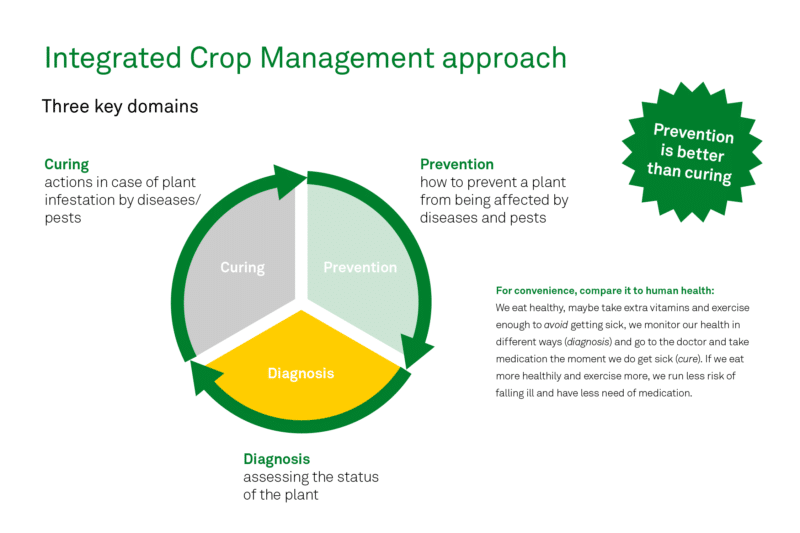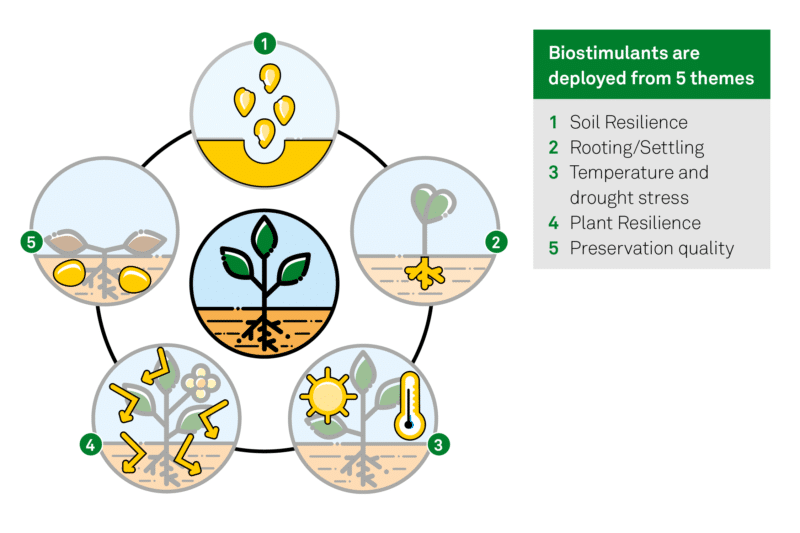Integrated cropping system for sustainable agriculture
Challenges
Agriculture is in a state of flux, partly to meet global challenges such as climate change and the consequences of the energy transition, but also in response to political and social pressure on the current method of cultivation. We are seeing environmental and food safety requirements become increasingly stringent, resulting among other things in the phasing out of important crop protection products without good alternatives being available. The costs of making the food chain more sustainable are not, or only to a limited extent, passed on in the chain, which puts pressure on the yields of crops and makes it difficult for growers to bear the additional costs of deploying alternative solutions. There is a strong call for better, greener production methods, with an increasing demand for green crop care products such as biostimulants.
We see a lot of potential in the development and deployment of technical innovations based on data and digitalization in order to still secure the yield and quality of crops, where Cebeco Agro can form a bridge between the current method and the deployment of the new techniques. In this way we are working towards a further integrated cultivation system.
Integrated cropping system
Integrated Crop Management (ICM) is a system approach at farm level in agriculture, aimed at crop production that balances the impact on production, economy and environment. Integrated Crop Production originates from the concept of ‘integrated crop protection’, but extends this approach beyond protection against pests and diseases. By combining all available knowledge about the various aspects of cultivation into a coherent approach, positive natural effects can be achieved on, among other things, soil quality and resistance to diseases and pests. As a result, fewer inputs are needed to ensure harvest quality.
Integrated cultivation consists of three main facets; prevention, diagnosis and curing. For simplicity, compare it to human health; we eat healthy, maybe take extra vitamins and exercise enough to prevent getting sick, we monitor our health in various ways (diagnosis) and go to the doctor and take medication if we do get sick (cure). If we eat healthier and exercise more, we run less risk of getting sick and have less need for medication. In short, how to prevent a plant from being affected by diseases and pests, how to assess the status of the plant (diagnosis) and what actions can be taken to cure the crop should it be in danger of being affected by diseases and pests. In each of these components we work on innovation, to improve the integrated cultivation system. After all, prevention is better than cure.
Prevention, diagnosis and curing
What contribution does Cebeco Agro make in improving the integrated cultivation system; how do we make the plant more resilient to diseases and pests (prevention), how do we improve the insight into the status of the plant and diseases and pests (diagnosis), and how do we improve the process of disease and pest control?
Prevention
Ideally, the plant should be resilient to abiotic and biotic stress factors and thus minimally susceptible to stress from, for example, heat or drought and to attack by diseases and pests. Factors such as soil health, crop care and biodiversity are highly determinant in this regard. Cebeco Agro offers various biostimulants that increase the resilience of the crop in various respects. Biostimulants are developed by Cebeco Agro for the following applications
For product information please contact Cebeco Agro
Diagnosis
It is becoming increasingly important to know better the status of the plant and the development of the disease or pest, because a better understanding allows a more targeted approach. This need is increasing because the new generation of crop protection products such as those of natural origin are more dependent on the plant and environmental conditions for proper effectiveness. Cebeco Agro is working with various partners to develop various decision support systems to provide the grower with more insight into the status of the plant and disease/pest to enable more targeted intervention.
Curing
Of course, intervention to prevent the crop from being affected by diseases and pests is an important element of cultivation, just as human health cannot do without medication. This intervention can be mechanical, think of the removal of weeds, and this can be done with synthetic and biological crop protection products. It is important to minimize the undesirable impact of the intervention, i.e. to reduce the environmental impact. This can be done, on the one hand, by using precision techniques to apply the pesticides only where they are needed and, on the other hand, by using pesticides with a more favorable environmental profile. The latter is an important spearhead for Cebeco Agro; increasing the available package of crop protection agents with a lower environmental impact for Dutch cultivation, such as basic substances. A basic substance is a substance which is already on the market for another purpose (for example as a foodstuff, such as vinegar or beer), but which also works and may be used as a crop protection agent. This is because any risks have already been determined during the original use. For more information on specific products, please contact Cebeco Agro.








